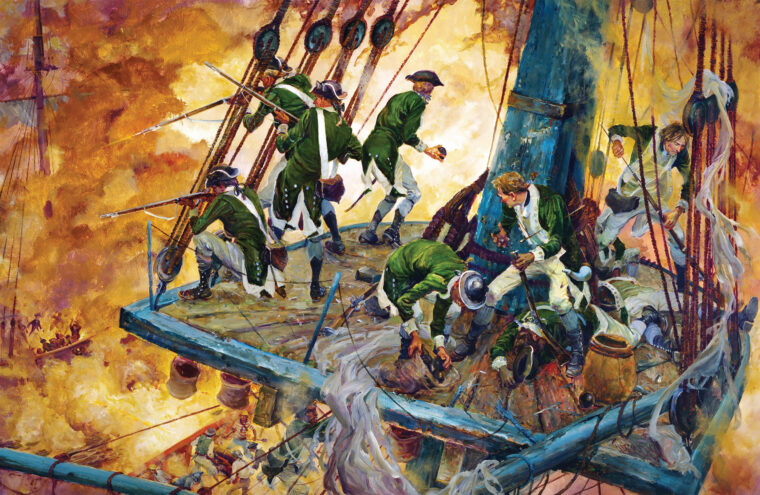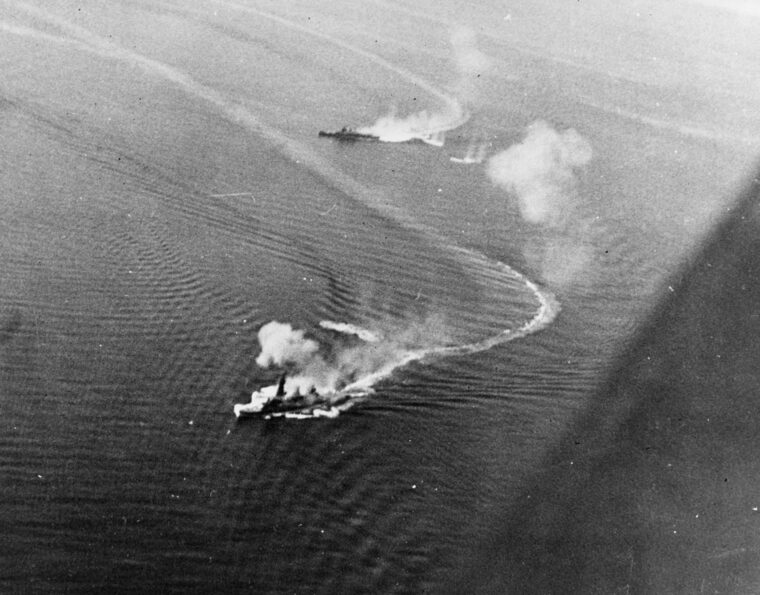


Teutonic Fury
By Ludwig Heinrich DyckAs part of tribal obligations to appease Rome, Segimer, the powerful Cherusci chief, surrendered his sons Arminius and Flavus to the Roman emperor Augustus. Read more

The Workhorse Lancaster
By Nigel PricePowerful, brisling with firepower and able to carry an amazingly large bombload, the majestic Avro Lancaster, along with the iconic Supermarine Spitfire, has come to symbolize the might of the Royal Air Force in World War II. Read more

Pollepel Island: Private Fortress on the Hudson
By Dorraine FisherIn central New York, 50 miles north of New York City on the Hudson River, is a small spit of land known as Bannerman Island. Read more

The U.S. Third Army and XIX TAC: Partners for Victory
By Sam McGowanIn the summer of 1944, the Third United States Army under Lt. Gen. George S. Patton made a spectacular dash across France, a daring advance that ranks high on the list of great military endeavors. Read more

Chris Kyle’s Precision Rifles
By Christopher MiskimonFrom the sniper’s perch, the city of Fallujah, Iraq, on November 7, 2004, looked dusty and brown. Most of the buildings were squat, two-story affairs, with the occasional minaret or domed mosque sitting above them. Read more

The Strange Odyssey of USS Stewart
By Glenn BarnettThe Spanish-American War saw the development of the torpedo as we know it today. It was not the static mine of the Civil War but a propeller driven, waterborne explosive device. Read more

The Battle of Chalons: Attila’s Stinging Defeat
By John WalkerIn AD 451, Attila the Hun, by then known to terrified Western Christians as the “scourge of God,” crossed the Rhine River in command of a multi-ethnic army. Read more

Lightning Assault on Pegasus Bridge
By Joshua Shepherd
At midnight of June 6, 1944, a trio of Halifax bombers, each towing a Horsa glider, roared above the black waters of the English Channel. Read more

Bloody Stalemate at Borodino
By John WalkerBy mid-afternoon on September 7, 1812, Russian troops had lost control of the earthworks on their left flank at Borodino. Read more

The Controversial M3 Grease Gun
By Patrick J. ChaissonNo one ever used the words “graceful” or “elegant” to describe the M3 submachine gun. Instead, those soldiers, sailors and Marines who carried it called the M3 a “plumber’s nightmare” or “the cake decorator.” Read more

Triumph Off Flamborough Head
By Eric NiderostStanding on the quarterdeck of his flagship Bonhomme Richard, Commodore John Paul Jones took his telescope and trained it northwards, sweeping the instrument to the left and right to see what his lookouts were reporting at midafternoon on September 23, 1779. Read more

Slogging into the Reichswald
By David H. LippmanJust after midnight on February 9, 1945, across the diamond-shaped mass of forest, hills, and flooded terrain that defined the Reichswald, rain fell in a steady downpour upon a battlefield that had already seen some of the most ferocious fighting of World War II in Western Europe. Read more

Grand Assault On Gibraltar
By David A. NorrisGreat Britain’s war with her rebellious American colonies was about to conclude as diplomats crafted a peace treaty. Read more

Lessons at St. Nazaire
By Robert F. DorrEven today, they don’t like to talk about the St. Nazaire raid.
Compared to the thousand-plane raids that went deep into Germany later in World War II, the January 3, 1943, bomber mission from England to the coast of German-occupied France was small and spanned only a modest distance. Read more

Military History Book Reviews for Winter 2023
By Christopher MiskimonA Handful of Heroes: Rorke’s Drift Facts, Myths and Legends (Katie Stossel, Pen and Sword Books, South Yorkshire UK, 2022, 201 pp., Read more

Perilous Fight For Peleliu
By Christopher MiskimonThe cacophony of naval gunfire proved so thunderous it left some marines in a stupor. Dark smoke roiled thousands of feet in the air from the bombardment of Peleliu, a small island in the Palau Islands. Read more

Steven E. Maffeo’s ‘Captain Chaos’
By Christopher MiskimonThe Battle of Leyte Gulf was the largest naval battle of World War II, and by most measures the largest in history. Read more

The World War II Diary of Lieutenant General James. M. Gavin
By Christopher MiskimonJames Gavin began his wartime service as the commander of the 505th Parachute Infantry Regiment during the Sicily operation, before assuming command of the entire 82nd Airborne Division for the remainder of the war. Read more

Prit Buttar’s ‘Meat Grinder’
By Christopher MiskimonFew in the West know about the Rzhev Salient. The fighting around Moscow and Stalingrad come quickly to mind, but this little-known salient near the town of Rzhev, roughly 100 miles west of Moscow, was so terrible it was nicknamed the “Meat Grinder.” Read more



